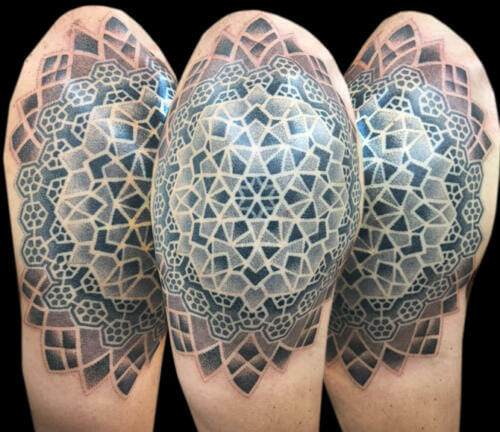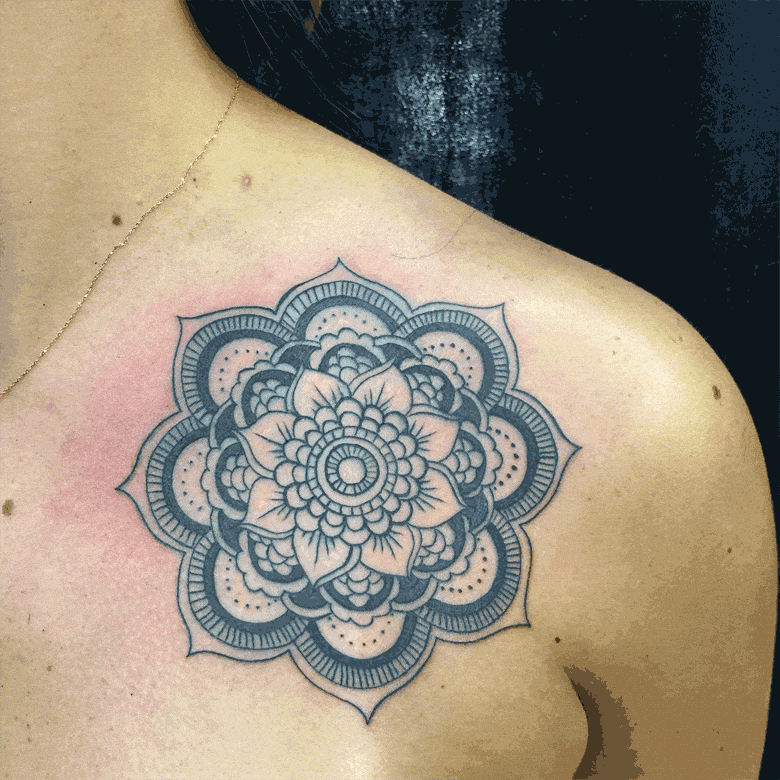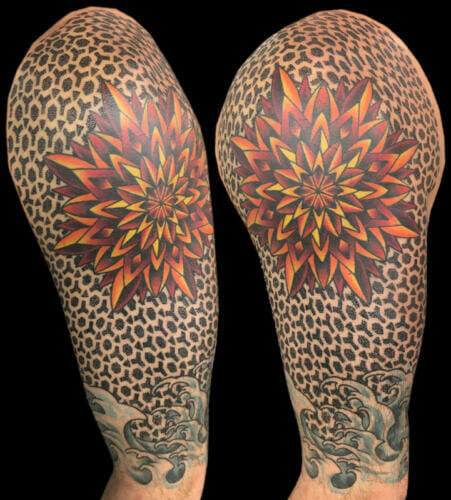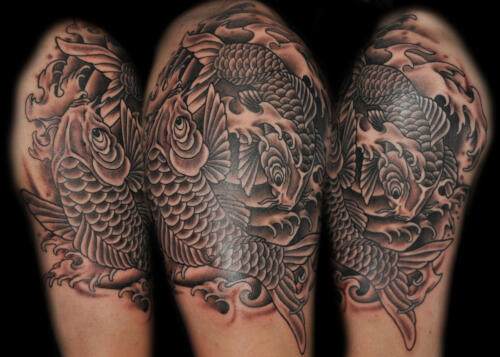
Mandalas have become increasingly popular in recent years, with their intricate designs and spiritual significance capturing the attention of people from all walks of life. These circular patterns have a rich history and can be found in various cultures around the world. From their origins in Hinduism and Buddhism to their use in Native American and Celtic cultures, Mandalas have a deep-rooted meaning that resonates with many individuals. In this article, we will explore the history, symbolism, and significance of Mandalas, as well as their connection to the rise of geometric tattoos.
What are Mandalas and Why are They So Popular?
Mandalas are geometric patterns that are often circular in shape. The word “mandala” is derived from the Sanskrit word for “circle” and represents wholeness, unity, and harmony. These intricate designs typically feature repetitive patterns and symbols that radiate from a central point. Mandalas can be found in various forms of art, including paintings, sculptures, and even tattoos.
There are several reasons why Mandalas have gained popularity in recent years. Firstly, their intricate and mesmerizing designs appeal to people’s aesthetic sensibilities. The symmetrical patterns and vibrant colors create a visually pleasing experience that captivates the viewer. Additionally, Mandalas have a calming effect on the mind and can be used as a tool for meditation and mindfulness practices. The repetitive nature of creating or observing Mandalas helps to focus the mind and promote a sense of inner peace.
The History and Origins of Mandalas in Different Cultures
The origins of Mandalas can be traced back to ancient Hinduism and Buddhism. In Hinduism, Mandalas were used as a spiritual tool for meditation and were often created using colored sand or rice grains. These intricate designs were believed to represent the universe and were used as a visual aid to help practitioners focus their minds during meditation.
In Buddhism, Mandalas were also used as a tool for meditation and were often created using colored sand or pigments. These Mandalas represented the universe and the journey towards enlightenment. The process of creating a Mandala was seen as a form of spiritual practice, with each brushstroke or grain of sand symbolizing a step towards inner peace and enlightenment.
Mandalas also have a rich history in Native American and Celtic cultures. In Native American culture, Mandalas were used as symbols of protection and healing. They were often created using natural materials such as feathers, stones, and shells, and were believed to have the power to bring balance and harmony to individuals and communities.
In Celtic culture, Mandalas were known as “Celtic knots” and were used as symbols of eternity and interconnectedness. These intricate designs featured interwoven patterns that represented the eternal cycle of life, death, and rebirth. Celtic Mandalas were often used in religious ceremonies and rituals to invoke spiritual energy and connect with the divine.
The Spiritual Significance of Mandalas and Their Symbolism
Mandalas hold deep spiritual significance in many cultures around the world. They are often seen as representations of the universe or the divine. The circular shape of Mandalas symbolizes wholeness and unity, while the intricate patterns represent the interconnectedness of all things.
In Hinduism, Mandalas are seen as sacred symbols that represent the cosmos. They are believed to be a visual representation of the divine energy that flows through all living beings. Creating or observing Mandalas is seen as a form of spiritual practice that helps individuals connect with their inner selves and the divine.
In Buddhism, Mandalas are used as a tool for meditation and are believed to aid in the journey towards enlightenment. The process of creating or observing Mandalas is seen as a form of mindfulness practice that helps individuals cultivate inner peace and clarity.
The Art of Creating Mandalas: Techniques and Materials

Creating Mandalas can be a deeply meditative and therapeutic process. There are various techniques and materials that can be used to create Mandalas, depending on personal preference and artistic style.
One popular technique for creating Mandalas is the “dotting” technique. This involves using a fine-tipped brush or pen to create a series of dots that form intricate patterns and designs. The dotting technique allows for precise control over the placement of each dot, resulting in a highly detailed and visually stunning Mandala.
Another technique for creating Mandalas is the “stippling” technique. This involves using a series of small dots or dashes to create shading and texture. The stippling technique can be used to create depth and dimension in a Mandala, adding visual interest and complexity to the design.
In terms of materials, there are many options available for creating Mandalas. Traditional materials include colored sand, rice grains, or pigments, which can be used to create temporary Mandalas that are often used in religious ceremonies or rituals. For more permanent Mandalas, artists often use pens, markers, or paints on paper or canvas.
The Different Types of Mandalas and Their Meanings
There are several different types of Mandalas, each with its own unique meaning and symbolism. Some common types of Mandalas include:
– Healing Mandalas: These Mandalas are often used in therapeutic settings to promote healing and well-being. They typically feature soothing colors and patterns that evoke a sense of calm and relaxation.
– Chakra Mandalas: These Mandalas are used in spiritual practices to balance and align the body’s energy centers, known as chakras. Each chakra is associated with a specific color and symbol, which is represented in the corresponding Mandala.
– Yantra Mandalas: These Mandalas are used in Hinduism as visual representations of deities or cosmic energies. They often feature intricate geometric patterns and symbols that represent different aspects of the divine.
– Nature Mandalas: These Mandalas are created using natural materials such as flowers, leaves, and stones. They often feature organic shapes and patterns that reflect the beauty and harmony of the natural world.
The Role of Mandalas in Meditation and Mindfulness Practices
Mandalas have long been used as a tool for meditation and mindfulness practices. The process of creating or observing Mandalas can help individuals focus their minds and cultivate a sense of inner peace and clarity.
When creating a Mandala, individuals often enter a state of flow, where they become fully absorbed in the creative process. This state of flow allows for a deep sense of concentration and focus, which can help to quiet the mind and promote a sense of calm.
When observing a Mandala, individuals often use the design as a focal point for their meditation practice. By focusing their attention on the intricate patterns and symbols, individuals can enter a state of deep relaxation and inner stillness.
Mandalas as a Form of Self-Expression and Personal Transformation
Mandalas can also be used as a form of self-expression and personal transformation. By creating or observing Mandalas, individuals can tap into their creativity and explore their inner selves.
Creating Mandalas allows individuals to express their thoughts, emotions, and experiences in a visual form. The process of choosing colors, shapes, and patterns can be a reflection of one’s inner state and can provide insight into one’s subconscious mind.
Observing Mandalas can also be a transformative experience. By immersing oneself in the beauty and symbolism of Mandalas, individuals can gain new perspectives and insights into their own lives. Mandalas can serve as mirrors that reflect back to us our own inner beauty and potential.
The Rise of Geometric Tattoos and the Mandalas Connection
In recent years, there has been a rise in the popularity of geometric tattoos. These tattoos often feature intricate patterns and designs that are reminiscent of Mandalas. The connection between geometric tattoos and Mandalas lies in their shared symbolism and spiritual significance.
Geometric tattoos, like Mandalas, often represent wholeness, unity, and harmony. The symmetrical patterns and precise lines create a visually striking image that captures the attention of viewers. Additionally, the process of getting a geometric tattoo can be a transformative experience, similar to creating or observing Mandalas.
The Meaning Behind Geometric Tattoos: Understanding the Symbolism of Mandalas
Geometric tattoos, like Mandalas, hold deep symbolism and meaning. Each shape, line, and pattern in a geometric tattoo can represent different aspects of life, spirituality, or personal beliefs.
For example, circles in geometric tattoos often represent wholeness and unity. Triangles can symbolize balance and harmony, while squares can represent stability and grounding. Lines can represent direction or movement, while spirals can symbolize growth and transformation.
Understanding the symbolism behind geometric tattoos is important for individuals who choose to get these tattoos. It allows them to connect with the deeper meaning behind the design and can serve as a reminder of their own personal journey and beliefs.

Caring for Your Geometric Tattoo: Tips for Aftercare and Maintenance
Proper aftercare and maintenance are crucial for ensuring that your geometric tattoo heals properly and maintains its vibrancy over time. Here are some tips for caring for your geometric tattoo:
– Follow your tattoo artist’s aftercare instructions carefully. This may include washing the tattoo gently with mild soap and water, applying a thin layer of ointment or moisturizer, and avoiding direct sunlight or excessive moisture.
– Avoid picking or scratching at the tattoo, as this can lead to infection or scarring. It is important to let the tattoo heal naturally and avoid any unnecessary irritation.
– Keep the tattoo clean and moisturized. Apply a thin layer of ointment or moisturizer regularly to keep the skin hydrated and prevent dryness or cracking.
– Protect the tattoo from direct sunlight by applying sunscreen or wearing protective clothing. Sun exposure can cause the colors in the tattoo to fade over time.
– Schedule touch-up appointments with your tattoo artist as needed. Over time, tattoos may fade or lose their vibrancy, so it is important to maintain regular touch-ups to keep your geometric tattoo looking its best.
In conclusion, Mandalas have gained popularity in recent years due to their intricate designs and spiritual significance. These circular patterns have a rich history and can be found in various cultures around the world. Mandalas hold deep symbolism and are often used as tools for meditation, mindfulness, and personal transformation.
The rise of geometric tattoos is closely connected to Mandalas, as both share similar symbolism and spiritual significance. Geometric tattoos allow individuals to express their creativity and explore their inner selves through intricate patterns and designs.
Whether through creating Mandalas, observing them, or getting a geometric tattoo, individuals can tap into the beauty and symbolism of Mandalas to find inner peace, balance, and personal transformation.









